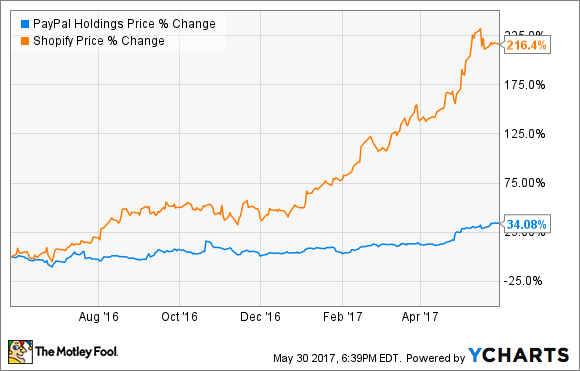This showdown is definitely a product of the paradigm shift to e-commerce. While most folks would think that ship has sailed, consider that online sales accounted for on just 8% of retail sales in the U.S. for 2016. Excluding cars and fuel from the equation pushed that figure higher to 15.6% of retail sales. Even at that rate, e-commerce still has a long runway ahead.
Let's look at our contestants. Shopify Inc. (SHOP 5.90%) provides merchants with a one-stop shop that simplifies the setup and administration of an online store, including a customizable multi-channel e-commerce and payments platform. The company's easy-to-use cloud-based service provides 100 templates and over 1,000 apps to customize the experience.
PayPal Holdings, Inc. (PYPL 0.17%) has grown from its roots as the best-known digital-payment method into a full-service payment processor and mobile wallet. The company has partnered will all the major credit card issuers, and its members can choose a funding source for each transaction, either online or in stores.
Both companies provide a vital service in the area of e-commerce, but which company is a better buy now?

In the race for e-commerce, which company has a superior outlook? Image source: Getty Images.
Financial fortitude
It is great to see that both companies have no debt, which gives them a measure of financial flexibility. Shopify's negative net income and free cash flow might be a cause for a greater degree of concern if it hadn't resulted from management's heavy reinvestment to grow the business. Still, Shopify has very little in reserves in the event of unforeseen circumstances or a financial downturn. That could lead to taking on debt or issuing additional stock, which would be dilutive to existing shareholders.
|
Company |
Cash |
Debt |
Net Income |
Free Cash Flow |
|---|---|---|---|---|
|
PayPal |
$1.24 billion |
$0.00 |
$1.61 billion |
$2.487 billion |
|
Shopify |
$101.27 million |
$0.00 |
($41.91 million) |
($9.39 million) |
Data source: YCharts. Chart by author.
PayPal, on the other hand has a significant amount of cash and is regularly producing more. This advantage puts the company on a much firmer financial footing.
Winner: PayPal.
Recent results and growth prospects
In its most recent quarter, Shopify grew its revenue to $127.4 million, up 75% year over year. At the same time, its monthly recurring revenue increased $20.7 million, up 62% over the prior-year quarter. Gross merchandise volume hit $4.8 billion, up 81% year over year, and gross payments volume increased to $1.8 billion, representing 37% growth over the prior-year quarter. Shopify also exceeded 400,000 merchants for the first time, up 45% from last year.
During its quarterly financial release, PayPal reported revenue of $2.98 billion, up 17% year over year. Its active customers increased to 203 million, up 11% over the prior-year quarter, while payment transactions increased to 1.7 billion, up 23%. Existing customers are also using the service more, with payments per customer increasing 12% year over year.
With e-commerce still in its early stages, both companies stand to gain from the evolving demographics, and both have been growing nicely. Shopify has the upper hand, having grown gross merchandise volume by over 100% year over year in six of the seven quarters since going public and sported revenue growth in excess of 86% year over year in every quarter since its debut.
Winner: Shopify.
Stock performance and valuation
Over the past year, both companies have outperformed the S&P 500 by a wide margin. PayPal stock is up 34%, more than double that of the index. And Shopify trounced both, with an astonishing return of over 200%.
Data by YCharts
To determine valuation, a number of metrics would normally be used, However, none of the usual metrics are applicable for valuing Shopify. The company is not yet profitable, as it has chosen to plow all it earns and more back into growth, so using a P/E ratio is useless, as is the PEG ratio. It's free cash flow-negative. Measuring price to sales, however, Shopify has a multiple of 18, compared with PayPal's less expensive 5 times trailing sales. Looking forward, Shopify sports a still-high multiple of 13, compared with PayPal's 5 times forward sales.
So while Shopify stock has posted better returns, PayPal's stock is less expensive.
Winner: Tie.
Final tally
The final tally reveals a tie. Which company to invest in will most likely depend on an investor's disposition. I believe that both companies have the potential to produce market-beating returns over the next several year, which is why I own both. But someone looking for a more risky investment, with a chance of a greater reward, might be more inclined toward Shopify, while an investor looking for less risk and a more secure financial footing will probably be inclined toward PayPal.


